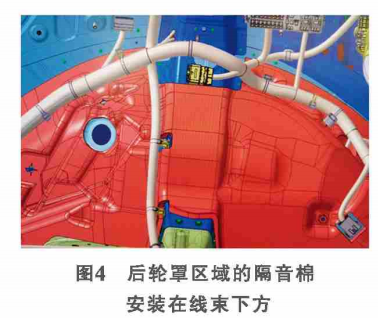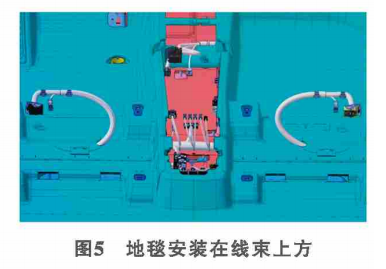1. Noise reduction in the wiring harness itself
When designing, fully consider the possible abnormal noise caused by the wiring harness itself. The abnormal noise generated by the wiring harness itself is the most direct for passengers. Therefore, when designing, we need to simulate a reasonable motion and assembly process, select reasonable wire harness fixing points, and select appropriate tie buckles. In addition, in areas where the wiring harness branch is close to the interior, it is recommended to use full wrapping of flannel tape for noise reduction treatment.
2. Sheet metal noise reduction
Try to avoid making holes in the firewall sheet metal and lower body sheet metal. When a car is driving, some of the noise and vibration come from the chassis. If more holes are opened on the firewall sheet metal and lower body sheet metal to fix the wiring harness, the car will bring significant noise and vibration when driving at high speed, increasing NVH and reducing the comfort of the car. Therefore, the fixing of wire harnesses on the firewall sheet metal and the lower body sheet metal should use as many stud clamps as possible. When designing, a requirement should be made to the sheet metal engineer to weld a 5mm or 6mm diameter stud for wire harness fixing. If there are some unavoidable wire harness holes, try to make smaller holes, and the size of the holes should be based on the largest sheath to be perforated. The common size of the opening is based on the diagonal size of the largest sheath to be perforated, plus 6mm as the diameter of the opening, leaving a gap of 3mm on both sides to ensure that the largest sheath can also pass through the sheet metal hole while reducing the opening of the sheet metal, which can minimize noise and vibration from the chassis.
3. Noise reduction in terms of soundproofing cotton and carpet
Try to avoid compressing the thickness of the soundproof cotton and reducing the opening of the carpet as much as possible. The soundproofing cotton and carpet belonging to the soft interior have the function of sound insulation and noise reduction, and the thicker the thickness, the better the sound insulation effect.
3.1 Sound insulation cotton
The thickness of the soundproof cotton is generally between 10-20mm, mainly arranged in the front panel of the passenger compartment and the left and right rear wheel covers. It plays a crucial role in the soundproof of the passenger compartment. Due to the sound insulation cotton being installed tightly against the body sheet metal, while the wiring harness is fixed to the body sheet metal, as shown in Figure 4 (the brown part is the sound insulation cotton), the thickness of the sound insulation cotton in contact with the wiring harness cannot be too thick, otherwise the wiring harness cannot be fixed to the sheet metal. In the area where soundproof cotton exists, priority should be given to selecting bolt clamps for fixing the wiring harness. This way, the soundproof cotton only needs to have small holes to avoid the bolts. At the same time, the bolts should also be selected with a longer length, such as a 20mm high bolt, which can leave a thickness of 8-9mm for the soundproof cotton and improve its soundproof effect. If welding studs cannot be provided in certain areas of the vehicle body, a raised buckle with a long circular hole can be used to achieve the same effect.
3.2 The thickness of carpet is generally between 10~60mm, which can greatly reduce noise and vibration from the chassis. The installation position of the carpet and the harness is opposite to that of the sound insulation cotton. The carpet is arranged above the harness, as shown in Figure 5 (the cyan part is the carpet). Therefore, the harness under the carpet should try to avoid using lifting clips to compress the thickness of the foam cotton in the carpet. If some wiring harness branches, such as seat wiring harness branches, need to pass through the carpet to connect electrical components, then a carpet opening is required. Generally, the size of the opening should be 10mm larger than the diameter of the wire harness branch that passes through. At the same time, a cross groove should be made with the center of the hole as the origin, and the length of the groove should be 20mm larger than the maximum diagonal length of the sheath that passes through, in order to facilitate the sheath to pass through and avoid large through holes that affect the sound insulation effect of the carpet.


